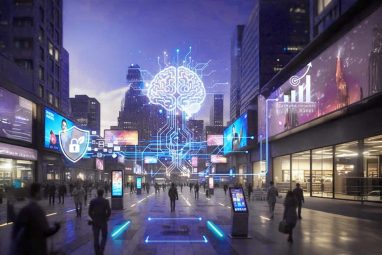A Guide to Marketing in a Post-COVID-19 World
COVID-19 has changed the game for the marketing industry. New consumer habits and expectations, as well new work processes, require marketers to evolve and adapt — without the benefit of established playbooks. How quickly marketers can adjust to the fundamental shifts will likely determine their success going forward. Though changes to consumers’ mindsets and workplace […]
Topics

COVID-19 has changed the game for the marketing industry. New consumer habits and expectations, as well new work processes, require marketers to evolve and adapt — without the benefit of established playbooks. How quickly marketers can adjust to the fundamental shifts will likely determine their success going forward.
Though changes to consumers’ mindsets and workplace practices were born during the COVID crisis, marketers should expect them to become permanent fixtures as they guide their brands and businesses into a new reality.
Keeping up with customers and the shift in their new realities is a big part of the job for marketers. They must maintain a fine balance between offering empathy and an escape from the pandemic. For example, a survey of consumers conducted during the height of the pandemic by the omnichannel communications solutions provider Mitto found that 41 per cent of respondents said they were ready to hear from brands about topics unrelated to the pandemic.
For many consumers, the striking similarity of COVID-related ads ultimately turned them off, and the messaging fell on deaf ears. What lesson can marketers learn from this? People have limited capacity for analogous advertising from brands, even when their intentions are good. If a brand can create an ad that is tonally appropriate but wholly different from those of competitors, it could pay huge dividends.
Fast-forward to 2021 and most consumers are transitioning to a more open environment, a return to normal. Pinterest carried out a study with their users where many spoke of a tension between excitement, and anxiety. Users are thrilled to see friends and return to more social settings. At the same time, they’re apprehensive about feeling comfortable in public spaces, returning to commutes and losing some of their flexibility from this past year. People claimed to have developed new positive habits during COVID. They created new rituals, reoriented their values and re-prioritised their time. They also showed pride in their personal growth. And as their lives get busier again, they expressed interest in making sure new habits stick. According to the study, they’re anxious they might lose these healthy routines once the hustle and bustle of life picks up again.
Here is what brands recommend marketers do to stay ahead of the curve:
Granular Monitoring of Data and Trends
According to a McKinsey report, marketers will need to think through how to manage today’s new wave of data and how to use it to personalise offers and messages to ever-narrower customer segments. Analytics will need to play a core role in enabling rapid response to opportunities or threats.
Unfortunately, putting marketing data to work remains challenging. One of the primary reasons is the disparate data sources within an enterprise. According to the Salesforce State of Marketing report, the average enterprise has 900 different applications, only about 28 per cent of which are integrated. Existing analytics models may not be as accurate when predicting behaviours in the next normal, and they will need to be rapidly trained on how to best use new behavioural data. In 2020, brands that fared well used data to gain customer insights and convert it into meaningful, empathy-led engagement.
Also Read: Rise of The Marketing Technologist
Deeper customer participation
According to Deloitte’s 2021 Global Marketing Trends, brands need to respond to the everchanging COVID-19 landscape, pivoting business models has become the norm. While the potential directions a brand can take are numerous, one path stands out among the rest: pivoting the way brands engage with customers. When Deloitte surveyed 405 executives in May 2021, 64 per cent said they transformed the way their organisation engages with customers to better respond to the pandemic.
The study found that customer engagement is quickly becoming a two-way street where customers participate as brand ambassadors, influencers, collaborators, and innovators. Marketers can benefit—and differentiate themselves from the competition—by crafting an engagement strategy that leans into participation at its deepest levels and maximises its mutual benefits for customers and brands. Customer participation represents both the passive and active ways in which people interact to influence brands. Passive participation may include low-touch, low-effort activities in which people provide feedback (like writing reviews) or discuss a brand, while active participation represents the more purposeful and involved ways people interact with brands (like co-creation and developing original content).
For example, The BMW Group, hosted virtual co-creation contests where hundreds of car enthusiasts submitted innovation ideas for both interior and exterior design concepts. What they learned from this exercise was that while 28 per cent of those who participated in online conversations engaged in the activity at least once a week, 37 per cent of those who provided direct input on design were active more than once a week. In essence, as people engage in deeper activities, they also participate in them more frequently.
Also Read: Get Your Arabic Website Rank on Google
Redesigned hybrid shopper journeys
According to a Gartner study, COVID-19 has unevenly reset businesses across industries where previously developed assumptions about buyer personas may no longer be valid. B2B saw the biggest change; Forrester analysts revealed that the quality of virtual interactions with B2B buyers was driving buying decisions, with 42 per cent of purchases now being made digitally. They are seeking more self-service options to make the best use of their time. This aligns with the new work from home model and new employee behaviours adapted due to remote working relationships.
Marketers will need to redesign shopper journeys to keep up with these changes. There is an opportunity for marketers here. We know the pandemic accelerated online behaviours. But what next? Consumer confidence in the use of e-services suggests a potential surge in demand and an opportunity to create new connections with people. One area of particular focus should be on developing partner ecosystems. For example, food marketers can partner with e-health platforms or online fitness companies to cross-promote the benefits of each to a wider audience. A home-buyer platform could include real estate, mortgage, moving, and bill-forwarding services tied into a single experience.








































































































